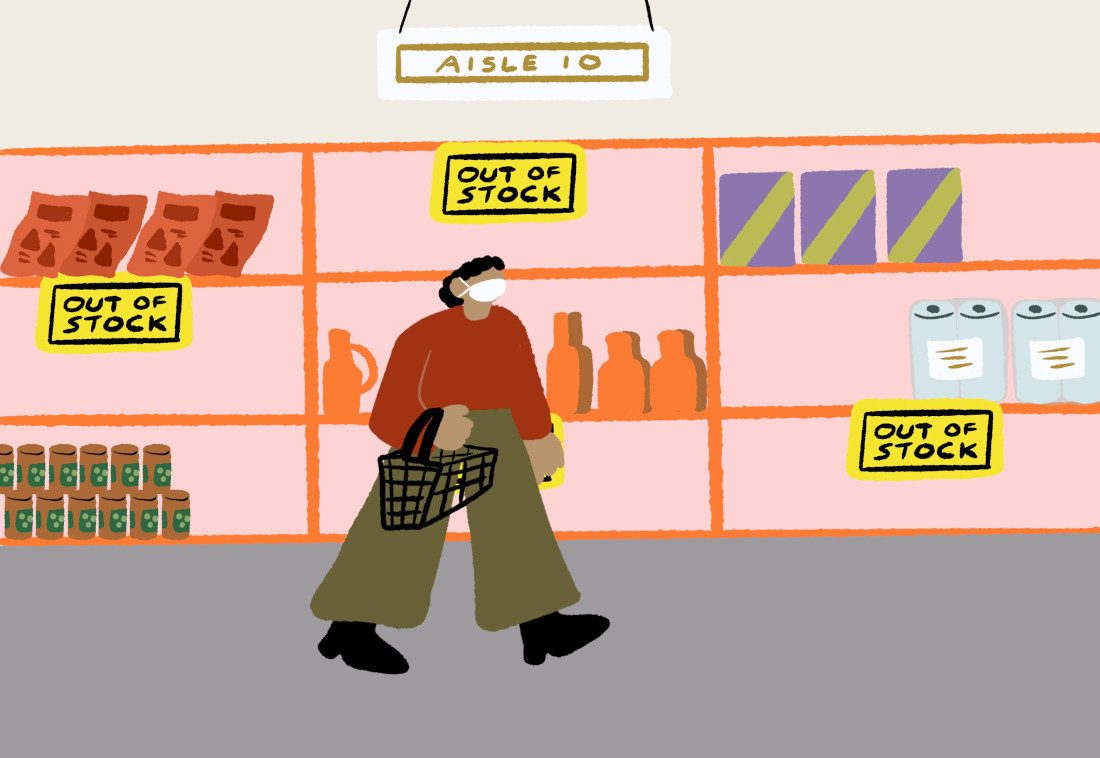Foreign labour, homegrown precarity
The hidden migrant work behind Canada’s food supply chain
Canadians often don’t think about the food supply chain until their favourite leafy green or salty snack is absent from grocery-store shelves.
What many fail to realize is that an absence of a product is often the result of the absence, or lack, of a person, too.
From production to distribution, Canada’s food supply chain is powered by migrant work – work that is often hazardous and even exploitative.
The journey of an organic tomato, from being picked to reaching a kitchen table, is a trail of challenges faced by migrant workers, including precarious legal status, wage theft and health hazards.
Grown by migrants
Radhika Desai, professor of political studies at the University of Manitoba
Santiago Escobar, a national representative for UFCW and long-time migrant-rights advocate, has witnessed the struggles of workers in the Seasonal Agricultural Worker Program (SAWP).
“The agriculture industry, without the support and labour of migrant workers, would be in trouble,” Escobar says.
Indeed, Canada has long relied on migrant labour to fill gaps in its system. Radhika Desai, a professor of political studies at the University of Manitoba, says this has resulted from a variety of dynamics. Primarily, she says migrant labour is recruited to fill labour gaps in sectors that cannot attract enough local workers.
“When capitalist economies are growing at a fast rate, they suck in labour like there’s no tomorrow. They come to the point where the demand for labour may go so high as to increase wages, which is something that capitalists don’t like very much,” Desai says.
“A lot of jobs that Canadians are not willing to do at the rates that are offered are typically the ones that go to migrants.”
The SAWP was established in 1966 by the Pearson government in hopes of filling local labour shortages in Canada’s agricultural sector with migrant work. In 2020, 50,126 temporary foreign workers (TFWs) landed on Canadian soil to work at farms across the country.
Stefan Larass, a senior policy advisor for the Ontario Fruit and Vegetable Growers’ Association, says many SAWP workers return to farms during the spring and summer months for several years and occasionally decades.
“The most typical frequency is around 10 years. That’s the median frequency, but some folks have come back for 30 years,” Larass says.
Despite the decades-long tenure of these workers, this is often not enough to receive permanent settlement in Canada. Further, a migrant worker’s ability to stay in Canada is often directly linked to their employer – an issue that Escobar says has led to the abuse of migrant workers, who fear deportation if they don’t comply.
In the time of COVID-19, the already hazardous nature of migrant farm work has been met with health and safety concerns brought on by the virus. In December 2021, Canada’s Auditor General (AG) released a damning report about the health and safety conditions migrant agricultural workers face. The AG found problems in 73 per cent of quarantine inspection reports in the agricultural sector.
“The main reason why these workers were so vulnerable to COVID was because they had to live in bunk houses, sharing a room with 12 to 14 coworkers,” Escobar alleges. “It’s impossible to practice physical distancing and impossible to implement anti-COVID measures.”
The federal government has made some attempts to improve the safety and security of migrant workers. In 2019, the federal government established open work permits for vulnerable workers under the International Mobility Program. The permits allow migrant workers who are experiencing or at risk of employer abuse to leave their job.
Since they were made accessible, Escobar says the UFCW has helped over 200 migrant farm workers obtain open work permits. In one case, they assisted 20 workers at a single farm.
“Two years ago, we assisted temporary foreign workers to leave that farm, and we have assisted, two weeks ago, other workers to leave that employer,” Escobar says. “We were shocked to learn that the federal government is allowing these bad employers to keep hiring temporary foreign workers.”
For this reason, Escobar believes the federal government is still complicit in allowing farms that have been accused of mistreating migrant workers, who obtained open work permits, to continue recruiting through SAWP.
As the growing season inches around the corner, farms across the country are preparing to hire another swath of migrant farm workers through the SAWP. Escobar, along with many other advocates for migrant workers, continues to plead for increased protections for TFWs.
Manan Gupta, publisher of Road Today magazine
Transporting goods, fighting wage theft
After produce is hand-picked or meat is processed, it has to go somewhere. Increasingly, TFWs are recruited to fill labour gaps in transportation sectors.
Despite the framing of the current anti-restrictions occupation as a “trucker” convoy, the majority of Canadian truckers – 90 per cent – are vaccinated. Increasingly, working truckers are racialized. More than half of all truckers in Vancouver and Toronto – 55.9 per cent and 53.9 per cent, respectively – are South Asian, according to a report from Newcom Media that drew from 25 years of Canadian census data.
Wage theft, long hours and an inability to access washrooms are issues many truckers face, according to Manan Gupta, the publisher of Road Today, a publication for South Asian truckers in Canada.
Gupta says an arrangement called Driver Inc. has allowed trucking companies to create loopholes.
“Basically, it’s a tax scheme used by many trucking companies where they misclassify their drivers as independent owner-operators,” Gupta says. “Say I am driving for Company A. I’m driving their truck, I’m only delivering what they ask me to, and I’m working based on their mandate. Ideally, I should be a company driver on their payroll, but what these companies do is ask their drivers to start their own incorporation.”
In doing so, Gupta says drivers lose out on benefits like vacation pay and overtime. At its most sinister, drivers wrongfully lose their wages.
In December 2021, a Toronto Star investigation revealed rampant wage theft being facilitated through Driver Inc. In the article, Stephen Laskowski, president of the Canadian Trucking Alliance, estimates that 20 per cent of the industry has been taken over by the “billion-dollar” scam, where companies illegally pocket roughly $15,000 in “savings” – that is, stolen wages – per worker.
The COVID-19 pandemic has also given rise to the popularity of food delivery services like DoorDash and Instacart, which have added additional steps to the food supply chain. Many newcomers to Canada are increasingly turning to gig-economy jobs. Yet, similar to truckers, the promise of freedom, mobility and independence remains a reach.
“The drivers think they are their own masters. They can file deductions for their cellphones, their office calls, all those related incidental expenses. But in the eyes of the CRA, that is not the right way, because, as a company driver, they don’t have any control (over) being independent,” Gupta says.
Challenges remain, but advocacy persists
Migrant-rights groups have been advocating on behalf of workers since the inception of the TFW program.
However, one of the greatest challenges in shedding light on migrant workers’ struggles is the lack of visibility in the public sphere. Migrant workers often work in isolated environments, which makes it difficult for the public and organizers to connect with them.
Larass says that despite many of the challenges, changes have progressively been made throughout the years to ensure migrant agricultural workers feel safe at work.
“There’s a lot of good developments, like workers having a tip line they can contact,” Larass says. “I think that’s the silver bullet. It’s giving people the power to speak up and not be afraid of getting fired.”
Many migrant workers aspire to become permanent residents in Canada and hope the temporary foreign worker program can act as a stepping stone.
“Many of these newcomers want to continue on their path to become a permanent resident in Canada” and eventually become citizens, Gupta says. “In that path, many of the labour issues come into action.”
Gupta suggests more education and training is needed for truckers on the occupational and legal hazards of the trucking industry.

Escobar, on the other hand, believes training isn’t enough. Workers need to be able to exercise their rights in the workplace, not just be aware of them.
“If these workers don’t have protections, the training is not enough. What’s the point of knowing your rights but not being able to put them into practice?” Escobar says. “We need to implement a program that will really address why these problems (exist) in the first place.”
At nearly every step in Canada’s food supply chain is the precarious labour of a migrant worker. Migrant workers sustain Canada’s food supply chain. They are essential workers in every sense of the word.
Published in Volume 76, Number 18 of The Uniter (February 17, 2022)




feature_1100_823_90.jpg)





